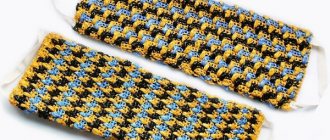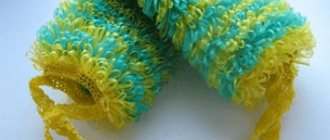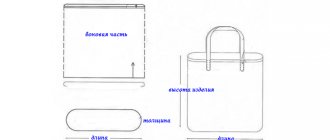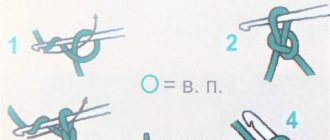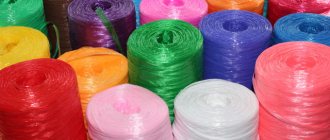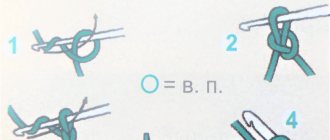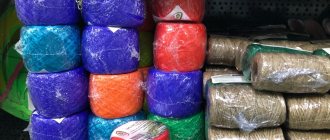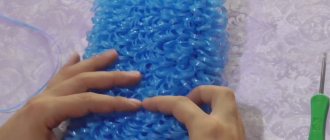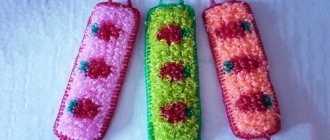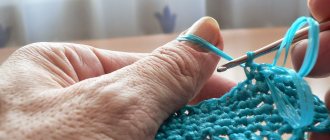A washcloth is an indispensable bath attribute. There are countless varieties, types and materials from which they are made. Any novice needlewoman can knit a toy washcloth for her child, or a bath washcloth made of natural material (sisal twine) for her own use. Each family member should have a separate washcloth and change it at least once every three months. Do-it-yourself knitting is a budget-friendly and practical solution. Crochet washcloths are made very quickly, and a creative approach will diversify their appearance and delight any child.
Crochet washcloths toys
Materials for knitting washcloths and their features
Before you start knitting a washcloth, you should choose for yourself what material it will be made of.
Natural ones themselves do not last long enough, as they are a favorable environment for the habitat and reproduction of pathogenic bacteria. Their service life is no more than 30 days. The same cannot be said about synthetics - their service life is about 90 days. At the same time, everyone can choose the material at their own discretion and preference.
- Cotton or linen threads
Perfect for children's, sensitive or irritated skin, as cotton itself is a very delicate and soft material.
To increase blood circulation, flax washcloths are suitable.
- Polypropylene twine
Durable synthetic material, foams well. Excellent for knitting with elongated loops.
Easily removes fatty, sweaty skin cells and removes dead skin cells.
For reference! You can also use twine made from natural materials (jute, linen).
- Sisal threads
For rough and hard skin. Used for making flat washcloths for massage.
Sisal toy washcloth
- Viscose
An artificial fiber from which very dense, high-quality and quite beautiful products are obtained.
- Acrylic threads
The reliability, strength and perception of this material are practically no different from viscose. It's just that different materials are used in production.
Accessories made from acrylic threads
- Polyethylene bags
This method of using bags is environmentally friendly and utilitarian. Washcloths made from bags are perfect for sensitive and delicate skin.
You might be interested in Making your own rag doll
Attention! This type of bath attribute is not suitable for using scrubbing products.
- Textile bags, nylon (women's tights), etc.
If you don’t have yarn, you can try to create something from scrap materials. This could be old women's tights, used flour or sugar bags, clotheslines, etc.
Turtle made from nylon tights
The crochet hook is selected directly to the thickness of the thread. You should not choose one with a sharp tip, since the threads are mostly multi-layered and will fluff, so the hook should be smoothly rounded.
How to choose threads for knitting washcloths
Threads come in different thicknesses. The thicker the thread, the tougher the finished washcloth will be. Select threads of such thickness that it is convenient to use them for crocheting No. 3-4. Although the most delicate and soft washcloths are crocheted No. 2, i.e. thin threads. Some people like washcloths that are harder and denser, while others like them softer.
Buy bright threads to match your bath accessories. For children, it is better to knit a washcloth from thin threads in the shape of a mitten or a funny animal.
Before the first use, be sure to keep the washcloth in boiling water for 5-7 minutes, the washcloth becomes pleasant to the body and lathers well.
Which yarn won't work?
Mohair, angora - all “fluffy” threads. To knit a washcloth, it is better to take non-fluffy yarn that will not deform if it comes into frequent contact with water.
What shape to knit a washcloth
A washcloth with elongated polypropylene loops can be knitted in the form of a pipe in a circle. It is convenient to insert foam rubber into such a washcloth.
- You can knit a flat rectangular washcloth according to the usual pattern using single crochets (only every third row is knitted with elongated loops):
- The crocheted washcloth can be oval-shaped (in this case, every third row is also knitted with elongated loops):
- A washcloth can be crocheted in the form of a mitten with or without elongated loops:
- Round washcloth (do not forget to knit every 2 or 3 rows with elongated loops):
- A washcloth for a child can be crocheted in the shape of any toy with elongated loops.
There is one more nuance: the longer the elongated loops, the softer the washcloth.
How to knit elongated loops:
If you have never knitted with elongated loops, then you should first try to knit a sample from simple threads in order to practice and work out the tightness of the knitting. The fact is that you need to knit tightly with long loops, i.e. Tighten each loop with columns so that the fabric is not loose. It will be especially difficult for beginners to immediately knit elongated loops from polypropylene threads.
Knitting patterns for elongated loops (choose the one that most understands you):
Knitting elongated loops on a ruler:
Beautiful funny DIY bath sponges
One of the brightest and cutest is the bunny washcloth. It is knitted using the elongated stitch technique. To begin, dial 20 cm VP. Connect them into a ring and knit 2 rows of sc.
- Start knitting the “hairy” part. Knit 2 rows of sc.
- Now you need to make a cone; to do this, pass the previous element through 2 sc. That is, for every 3 elements of the previous row you must knit only 2
- Knit until all the loops are connected at one point. Decorate the face, tie long ears and a tail
How to choose threads?
Let's take a closer look at each type of thread. Among the natural fibers suitable for knitting washcloths are:
- Hemp, made from hemp fibers.
- Jute is made from textile fiber. It makes hard products.
- Bast is rich in phytoncides, but is short-lived.
- Cotton is not very practical for washcloths.
- Wool is often used for washcloths.
- Sisal is obtained from the fibers of agave leaves and is used mainly for washcloths. It has good foaming properties and effectively cleanses the skin, providing a scrub effect.
- Flax fibers are soft, durable and dry quickly, and their qualities only increase over time. Such washcloths have numerous therapeutic and health effects on the body.
Knowing the disadvantages of natural materials, housewives still prefer synthetic fibers:
- Nylon and nylon threads, which are often used to strengthen wool. Often unwearable tights and stockings are turned into original peeling items.
- Polyethylene, ribbons of plastic bags make high-quality bath accessories.
- Viscose.
- Acrylic fibers.
- Polypropylene, the most practical and popular material for needlework.
- Rubber (rubber), today chemists have learned to produce rubber yarn, although it is rare on sale.
- Polypropylene yarn, which has increased strength. It is convenient to work with, and knitted products take good care of the body. Today, housewives have begun to combine polypropylene thread with other types of yarn, so the products come out soft and durable. Often in master classes, when knitting, pieces of foam rubber are inserted inside to give the washcloth softness.
How to knit baby washcloths with your own hands
Many needlewomen knit products on their own. Things and household items made with your own hands look stylish and original. Everyone knows that a washcloth needs to be changed once every three months, like a toothbrush and other personal hygiene items. After all, bacteria and dirt accumulate on these products. Washcloths can be made from different materials and yarn. The main thing is that the threads are of high quality, otherwise the product will quickly become unusable from exposure to hot water and soap. Yarn for washcloths
Yarn for washcloths Yarn for washcloths made of polypropylene can be of different colors. If you want, you can make such products from natural materials in the form of birch bark, rubber and others. Remember: Washcloths made from natural materials must be changed every month. Otherwise, this personal hygiene item will turn into a real breeding ground for bacteria.
Children's washcloth
Beautiful crochet baby washcloths with your own hands: diagrams
Beautiful crochet washcloths: pattern This washcloth is crocheted like a mitten, the steps for creating which are described above. The difference between a children's product is that it will be smaller in size and can be decorated.
Beautiful crocheted washcloths for beginners - animals How to crochet a toy washcloth? Caring parents know that children develop through play. Therefore, even while bathing, the baby should frolic and play. How to crochet a funny washcloth toy? The knitting pattern for washcloth mittens will help you create interesting bath toys. It will be fun for your child to swim with them. Older children will even want to rub such a washcloth with soap themselves.
Washcloth "Kitty"
How to crochet a washcloth toy? Frog washcloths You need to knit such products like a mitten. Knit the muzzles in a circle with a yarn over of a different color.
How to crochet a washcloth toy - baby frogs Crochet washcloth Hedgehog
Crochet Hedgehog washcloth Hedgehog is one of every child’s favorite characters. If your little one doesn't like bathing, then crochet a Hedgehog washcloth for him and he'll look forward to the evening to take a dip in the bath with his new friend. Cast on 32 loops and knit 2 rows in a circle with a single crochet. Then knit with elongated loops. Knit 30 rows with a double crochet. After that, change the thread of the main color to the thread from which the muzzle will be made. Continue knitting with a single crochet from 31 to 35 rows with a single crochet. Decrease 4 loops in each row - the muzzle is ready. Fasten the thread, make a nose and eyes for the hedgehog using a needle and thread. Children's toy washcloths with elongated crochet loops. It is better to knit any toy washcloths with elongated loops. This technology helps create a beautiful and soft personal hygiene item for the baby. Make these children's toy washcloths with elongated crochet loops:
Children's washcloths toys with elongated crochet loops
Baby washcloths with elongated crochet loops
Children's washcloths toys with elongated loops Knitting with elongated loops is also called “fur”. Using this technique, you can knit not only washcloths, but also hats, scarves or sweaters.
Children's washcloths toys with elongated loops with a "fur" pattern
Children's washcloths toys with elongated crocheted loops - technique for making a "fur" pattern Important: If holding the loop with your finger is uncomfortable, you can put it on a strip of thick cardboard. Crochet round and oval washcloth Crochet round and oval washcloth is the simplest product that every woman can make. Oval knitting pattern:
Crochet oval washcloth - pattern Circle knitting pattern:
Tie the edges with a contrasting thread in two single crochets. Tie chains of 40 loops on the sides - these will be handles.
Washcloth with knitting needles with elongated loops - diagram
A washcloth with knitting needles with elongated loops - diagram. The elongated loops are the same size, so this knitting looks beautiful. Washcloth with knitting needles with elongated loops - diagram:
Sponge with knitting needles - diagram
How to knit a washcloth toy: diagrams
If you have mastered the simplest crocheting techniques, choose simple patterns. A simple option is a pipe washcloth. Dial 30 VPs and connect them into a ring. Now knit in a spiral pattern, dc, until you get the stocking of the desired length. Tie the handles. Pay attention to the choice of yarn, it should be stiff enough, nylon threads are suitable.
Features of knitting
The principle of making children's washcloths is not much different from adults, the only difference is the design. Children love a variety of animals and cartoon characters. Based on this, tie a washcloth. The easiest way is to knit a mitten with the face of a bear or rabbit.
- Measure the circumference of the child's arm and dial twice as many VPs plus 8 more pieces
- Connect them into a ring, tie a sc
- Knit 5 rows, now knit 7 VPs in the middle and connect them with a blind loop to the resulting pipe. This is a finger hole
- Continue knitting the pipe for another 8 rows. Reduce the number of columns by 4 pieces in each row. Knit until all the stitches are gone
- You should get a cap or bowl. Tie the finger sc.
- All that remains is to decorate the washcloth with a handle and design the face. Tie round ears on both sides of the mitten. Make a small nose and eyes
- You can embroider these parts of the muzzle with threads
Do not use buttons or other plastic accessories as they may melt. Combine yarn of different colors.
Washcloth from bags
If you find a suitable pattern for knitting a washcloth, you can knit it from plastic bags. These can be regular bags without handles or multi-colored garbage bags. Before you start, you need to prepare the packages. For a regular washcloth you will need about 30 pieces:
- Lay a roll of garbage bags horizontally on the table.
- Fold the fabric upwards, leaving 5 cm at the top.
- Cut the folded edge into strips 3 cm wide, not cutting the roll all the way through.
- Expand the packages. You will receive fringe made of polyethylene.
- Make oblique cuts in the upper part of the workpiece, going from the 1st strip to the 2nd, from the 2nd to the 3rd, and so on.
- As a result, you should have a long strip that you can roll into a ball and start knitting.
Crochet hedgehog washcloth
Hedgehog made of polypropylene
In order to make a hedgehog washcloth you will need polypropylene thread. Although the toy looks very cute and attractive, it itself is a bit harsh to use. It can only be softened with a softer material, but then the shape will change and the overall strength of the accessory will be lost.
Step-by-step master class:
- First you need to cast on a row consisting of 32 air loops. After the last loop has been cast on, it needs to be connected to the first. You should get a circle of loops.
- Now you need to create two rows by knitting a sc (single crochet).
- Then 30 rows are knitted, pulling out the loops, as in the picture below, so that the hedgehog turns out fluffy.
Knitting with elongated loops
Just a little left:
- The next step is knitting the muzzle. For this you will need white yarn. Repeat the simple column 5 times, then decrease 4 stitches in each subsequent row until one remains. Cut the thread, fasten and hide.
- For the eyes and nose you will need thread and a needle; you can choose the color of your choice.
On a note! You can make a berry the same viscous texture by choosing the right color scheme. These washcloths look very beautiful, they can be presented as a gift or souvenir.
Round washcloth for washing dishes
You can knit a small washcloth from scratchy synthetic threads or a rope for washing dishes.
- Tie a rectangular pipe using the method described above.
- Sew the edges together using a smaller crochet hook.
- Thread the thread through one corner of the workpiece and pull it through the opposite one.
- Pull the workpiece, you should get a ball with folds.
- Secure the thread and make a loop for hanging.
With the help of a hook and imagination, you can make a wide variety of washcloths in appearance and purpose. And if you take used bags rather than purchased yarn, you will not only decorate your home, but also help the environment.
Washcloth Mitten-bunny
Knitted bunny mitten
In order to start knitting mittens-toys, it is better to try to knit a simple washcloth without additional accessories. The scheme is very simple and accessible even to the most inexperienced needlewomen. Also, at the very beginning, you can allow yourself not to knit your thumb, nothing serious will happen from this, but it will be faster to fill your hand with knitting.
Detailed pattern of knitting from acrylic threads:
- You need to cast on a chain of 30-35 air loops (you should focus on the circumference of the arm on which you are knitting), and connect the first and last. You will get a circle of loops.
- Now you should knit in the round using single crochets. On each next row you need to knit a lifting air loop.
- You should knit until the size of the mitten reaches the desired size.
- To join the edges of the circular stitch, they will need to be joined together using a single crochet stitch.
This is the easiest way to knit a washcloth-mitten. After the main work is done. You can complement it with accessories, knit the ears separately and knit the eyes, nose and muzzle.
An option for knitting a mitten with fingers is shown in the diagram below.
Scheme of the mitten-toy bunny
The ABCs of knitting for beginners
It would seem that what’s so difficult about tying a washcloth? Take suitable yarn and a hook, and calmly work according to the pattern. However, not everything is as simple as it seems at first glance. And the whole problem lies in the correct choice of working tools and materials.
Firstly, bath sponges are knitted from special polypropylene threads, which are very difficult to work with. They stretch, flake and in every possible way interfere with the beginning needlewoman. This is where a properly selected hook will come to the rescue. You need to choose a medium-sized hook with a rounded rather than sharp head. Sizes No. 3, 4 and 4.5 are best, but you can choose another depending on the thickness of the thread.
Secondly, washcloths are needed not only for hygiene procedures, but also for washing pans, pots and other kitchen utensils. Regular cotton yarn is also suitable for these purposes. But it is better to imitate elongated loops with an air chain, the edge of which must be fixed in the same stitch.
To clearly show how both methods work, we have prepared two detailed photo tutorials especially for you.
Crochet owl washcloth
A detailed description and instructions on how to crochet an owl washcloth are not needed in this case, since it completely repeats the steps of crocheting the previous toy. The only thing is that instead of ears you should tie eyes, as shown in the picture below.
Crochet owl washcloth
In this case, the material used is blue and light blue polypropylene.
What does a mitten look like?
The entire toy is made of cap loops, a detailed description of which was indicated earlier.
Owl from the side
It won’t be difficult to find and learn how to crochet a cat, mouse, hedgehog, owl, etc. washcloth in the open spaces of a boarding school. But it’s best to start with the simplest, then in the future the process will not turn into a burdensome work, but into a fun and carefree process. And finally, after the washcloth is made, it should be soaked in boiling water for 10-12 minutes, then it will become much softer, more pleasant to the body and will be more willing to lather.
How to crochet a chicken?
To make a chicken washcloth, you need to use 2 skeins of yellow yarn, since the product is knitted with a double thread. For decoration you will need some red and black material.
- We connect a chain of 35 VPs into a circle.
- We create two rows with a double crochet (C 1/n).
- Then we knit the elongated loops on the wrong side. We wind the loose thread around the finger, insert the hook into the bottom row C 1/n, while picking up the thread from the finger, we pass the hook through the column. Throwing a thread over it, we thread the yarn through 2 loops on the hook. A fluffy loop should come out.
- Then we make a row C 1/n and alternate it with elongated rows.
- Having reached the thumb (9 rows), we begin decreasing: alternating 4 C1/n with 1 unknitted stitch.
- The row with elongated loops is left unchanged.
- Next is a row of alternating 4 C1/n with 1 unknitted stitch.
- 3 rows before the end, the elongated loops are not knitted, but the decreases do not stop. The posts close and turn the product inside out.
- The comb is formed with a red thread from the middle of the top (8-9 sc.b/n and 1 row of sc.b/n).
- The outline of the eyes is embroidered from black thread.
- For the beak, take 4 VPs and attach them to the base. The surprise for the children is ready.
How to crochet a strawberry?
If you want to add a bright strawberry note to your bathroom, then start knitting a “delicious” strawberry washcloth. Red and green polypropylene thread is suitable for it. If the item is intended for children's skin, take a softer yarn. For a strawberry (12 x 18 cm), a tiny piece of foam rubber is needed for filling.
- Having dialed 3 VPs, we close them in a ring, and from the center we take 6 STBN.
- Gradually add 6 loops per row.
- Let's create elongated loops in a circle. Having collected 10 rows, put the foam rubber and begin cutting the loops (two together) until the ring closes.
- Using the diagram, we will make 6 green leaves and a red flower. Carefully sew the parts to the top of the product.
- From 20 VP we will make a loop.
Toy - washcloth Frog
Toy washcloth “Wakka the Frog” made of yarn - 100% nettle fiber from Laines du nord (Italy).
Yarn consumption: green 30g, white 10g, 3 wooden beads, a little pink thread for a flower. Hook 2.5 mm.
Toy washcloth “Wakka the Frog” made of yarn - 100% nettle fiber from Laines du nord (Italy)
For those who want to create such a washcloth toy, I am posting a step-by-step description with enlarged photographs.
The frog consists of a head with an opening mouth, two eyes and a cylinder body. Easy to put on for adults and children. Yarn - 100% nettle fiber (pleasant and not at all stiff) - Scilla Laines du nord - 135m/50g I think that any other natural yarn will do, preferably ribbon or perhaps a good acrylic thread.
Yarn consumption: green 30g, white 10g, 3 wooden beads, a little pink thread for a flower Hook 2.5 mm
1. Knit a circle D=8.5 cm according to pattern 1
2. Perform 2 rows according to pattern 2 with lush columns
3. To perform the opening mouth, knit exactly half the loops of the circle with a chain of chain loops and attach to the head, finishing with a row of sc.
4. Eyes and flower. For the eye, I cast on 8VP with white thread and tie the 16th RLS, then I attach a green thread and knit another row of RLS, doubling every second loop. Then, without adding, I knit another row, grabbing the back of the loop (this is how I form the back half of the eye circle) and now everything is in the reverse order - I cut through the loop, and then each loop. Sew on a bead. In company, tie the second one to one eye and sew both at the required distance. To decorate the Frog Girl, you can knit a flower and also sew it to the head.
5. Work 2 rows according to pattern 2, alternating white and green threads.
6. To give the head a shape, you need to knit one lush column under the mouth in the third row instead of a rosette of lush columns (PS+VP+PS)
7. Knit the body of the Frog according to scheme 2 (replacing the PS with just a DC) to the required length and decorate the bottom with white thread with any openwork
8. Mouth - you need to knit a circle from the PS, I did it according to the diagram below, the knitting order was carried out according to the method posted on the network, but you can do it according to the circle rule for the SSN
Attach the oral cavity with half-columns.
And now you will have such a sweetie sitting next to you)
Conventional abbreviations: VP - air loop, RLS - single crochet, SSN - double crochet, PS - puffy stitch
Original washcloth in the shape of a hedgehog
Despite its visual appeal, this sponge is rougher, because the original is made of polypropylene. You can experiment and knit it in soft yarn, however, we do not guarantee that you will be able to maintain the overall relief of the figure. In any case, a polypropylene hedgehog washcloth can act as a great hand-made gift or even just as a bright accessory in the bathroom.
Knitting a hedgehog begins with an air chain - a loop for hanging a washcloth. We cast on 20 VPs, close them in a circle with an SS, and knit a sc on top. From the first VP, located at the SS, we raise 3 more VPs, sc + 32 VPs (for the hedgehog’s body), SS.
We continue to knit in a circular manner, knit rows No. 1-2 without increasing 36 RLS.
Row No. 3: we begin knitting elongated loops - “spines”, which can be either the same or different in the degree of “elongation”. To knit elongated loops, you need to insert the hook into the PR loop and knit according to the principle of a simple sc, while pulling out the loop, but not finishing the stitch. It turns out that there are 2 loops on the hook, in parallel we put the working thread on the thumb, we knit another loop from this loop, we get 3 loops on the hook, after which we knit all three loops at once so that they do not come apart. We knit the third row with 24 stitches with elongated loops + 12 sc.
Rows No. 4-30: knit in the same way.
Rows No. 31-35: start knitting with white thread, 36 regular sc.
From the 36th row we begin to decrease to decorate the hedgehog’s face, up to 32 sc in the row.
In rows Nos. 37-41 we continue to decrease by 4 stitches, in the end we get 12 sc.
Row No. 42: knit 12 sc with the main color of yarn.
Row No. 43: continue decreasing, skip one stitch, next. We knit RLS and so on until the end of the row, 6 RLS remain.
Row No. 44: decrease, as in PR, we get 3 RLS. We fix the SS.
Using blue (black) thread we embroider the eyes, nose and mouth. The hedgehog is ready!
Materials
The main thing in knitting a washcloth is the choice of materials. Each person has their own skin sensitivity and preferences. Some people like hard washcloths, while others prefer foam sponges. This must be taken into account when selecting yarn.
To knit a washcloth with knitting needles, you can use the following types of yarn:
- Jute is a textile fiber that can be purchased at a hardware store. A hard material that cleanses dirt well and has a massage effect.
- Bast is a natural material. Washcloths made from it are good for health, have a beneficial effect on the skin, and do not cause allergies. But they have a short service life.
- Sisal is a natural fiber often used to make washcloths.
- Linen is a natural fiber with medium stiffness. It lathers well, washes and dries well. Hypoallergenic.
- Cotton is an accessible and inexpensive material. Used for soft washcloths for delicate and sensitive skin. You can replace it with knitwear cut into thin strips, for example, from old T-shirts.
- Wool is a natural material that makes bright, medium-hard washcloths. The yarn is easy to work with.
- Acrylic is a synthetic fiber that can be used to make fun baby bath accessories.
- Nylon and nylon are synthetic fibers for soft washcloths used for the face and sensitive skin or for dishes. To reduce costs, you can cut used nylon tights into strips. They need to be washed first.
- Polypropylene yarn is the most common material for knitted and crocheted washcloths. It is wear-resistant, holds its shape well, and has a massage effect. You can find many color options on sale. You can buy it in hardware departments. You need to choose a thread, not twine twisted in several layers.
Detailed tutorial on knitting toy washcloths: Mouse
Have a nice good day everyone!!! I decided to make a small tutorial on knitting a toy washcloth. 1. Threads - I use polypropylene thread "Master"
but you can also use another polypropylene thread such as Hostess-needlewoman, Needlewoman or similar threads intended for knitting washcloths Hook No. 3 - I really feel sorry for Clover, so Chinese with a bamboo handle 2. First we will knit spare parts Eyes
do not forget to leave enough thread to sew the eyes onto the washcloth Ears
we can figure it out from the photo, you can do it without ears 3. We knit a loop - 4 double crochets, 6 rows
connect together
then a chain of 48 air loops - this is the optimal number in my opinion
close it in a circle, be careful not to twist it. Knit with single crochets for 4 rows.
Then we begin to knit the carcass - one circular row with elongated loops, the second row with single crochets (we will count two rows as one)
4. We continue to knit the carcass alternating colors - 4 rows of one color, 4 rows of another color
5. In the fifth color strip after the second row with elongated loops, before knitting with single crochets, mark the middle and knit the ears
and finish the fifth lane
6. We knit the muzzle. Divide the circle into 4 parts and make decreases in each circular row up to 6 loops between decreases.
You can try on the eyes Take a needle and sew the eyes on the selected places
7. We continue to knit and decrease up to 2-3 stitches between decreases. Fasten and cut the main thread
We attach a black thread and knit a nose - the first circular row without decreasing, and then we decrease through one loop in a circle. Our mouse is ready
My experience - in each color row I cut the thread and attach a new one
Crochet baby washcloths
A knitted washcloth for a child should not only fulfill its main function, but also be interesting to the baby. To make the washing process a joy. For these purposes, needlewomen have come up with various patterns for knitting washcloths.
With a three-dimensional pattern
A do-it-yourself washcloth for children can be knitted according to a pattern. That is, you knit a simple fabric from single crochets, and on it you knit a fish, a duck, a bow or any other object with voluminous (lush/embossed) stitches.
Fish washcloth, knitting patterns
Knit one or two identical fabrics in the shape of a fish according to the pattern. You can use bright baby yarn. Do not decorate a baby washcloth with plastic eyes or other accessories to avoid scratches.
Children's washcloth toy
An interesting knitting option, but you need to think about how to fill it. You can use special granules that are sold in craft stores just for this purpose (filler for toys). They are made of plastic, will not get wet, and the washcloth will dry quickly.
There is enormous scope for creativity here: fish from the cartoon “The Little Mermaid”, yellow ducks, sharks, turtles, etc.
Voluminous double crochet washcloth
Everyone once had or has such a washcloth. This analogue is easy to knit with your own hands. The scheme is simple.
Let's take a hair elastic as a base.
This is not necessary; you can use a standard set of air loops.
We tie it with double crochets as shown in the video = 44 treble crochets
1 row. 2 treble s/n in each treble s/n of the previous row. = 88 st.s/n
We knit all subsequent rows in the same way: 2 double crochets in each column of the previous row. The photo shows a 7-row voluminous washcloth. You can knit more or less as you wish.
At the end, tie 50 vp. and attach the string to the washcloth.
